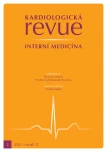Iodine saturation in Czech Republic and globally – shortcomings and perspectives
Authors:
V. Zamrazil
Authors‘ workplace:
Endokrinologický ústav, Praha
Published in:
Kardiol Rev Int Med 2015, 17(2): 167-171
Category:
Internal Medicine
Overview
Iodine is an essential element and a component of thyroid hormones triiodothyronine (T3) and tetraiodothyronine (thyroxine – T4). Thyroid hormones are potent regulators of energetic metabolism and differentiation. Its reservoir is seawater; lack of iodine (iodopenia) is frequent in continental regions. Consequences of iodopenia affect the entire organism. Sufficient intake of iodine for adult persons is over 150µg/ daily (for pregnant women 250µg/ daily). Criteria for evaluation of iodine saturation are as follows: concentration of iodine in urine (ioduria), prevalence of goitre, thyroglobulin level and parameters of thyroid function. The Czech Republic is a region of iodine deficiency. A complete programme of iodine supplementation can compensate this defect and therefore, according to WHO criteria, the CR is considered as a country with compensated iodine deficiency. The effects of increased iodine intake on thyroid autoimmunity are still questionable. The current trend in reduced consumption of salt, as part of the prevention of cardiovascular disease, may be a risk factor for iodine saturation that should be systematically monitored in order to prevent its decrease and its possible negative effects on intelligence and general quality of population.
Keywords:
iodine – thyroid gland – goitre – hypothyroidism – cretinism
Sources
1. Zamrazil V, Čeřovská J. Jod a štítná žláza. Praha: Mladá fronta 2014.
2. Zimmermann MB, Jooste PL, Pandav CS. Iodine deficiency disorders. Lancet 2008; 372: 1251– 1262. doi: 10.1016/ S0140‑ 6736(08)61005‑ 3.
3. Čeřovská J, Bílek R, Zamrazilová H. Změny zásobení jodem české dospělé populace po eradikaci jodového deficitu a jejich příčiny. Randomizovaná studie dospělé populace dvou regionů České republiky s odstupem 5 let. Vnitř Lék 52; 2006: 858– 863.
4. Zamrazil V, Bílek R, Čeřovská J. Jodový deficit ve světě i v České republice – současný stav a perspektivy. Vnitř Lék 2010; 56: 1310– 1315.
5. Zamrazil V, Bílek R, Čeřovská J et al. The elimination of iodine deficiency in the Czech Republic: the steps toward succes. Thyroid 2004; 14: 49– 56.
6. Andersson M, Karumbunathan V, Zimmermann MB.Global iodine status in 2001 and trends over the past decade. J Nutr 2012; 142: 744– 750. doi: 10.3945/ jn.111.149393.
7. Aceves C, Anguiano B, Delgado G. The extrathyronine actions of iodine as antioxidant, apoptotic, and differentiation factor in various tissues. Thyroid 2013; 23: 938– 946. doi: 10.1089/ thy.2012.0579.
8. Grais IM, Sowers JR. Thyroid and the heart. Am J Med 2014; 127: 691– 698. doi: 10.1016/ j.amjmed.2014.03.009.
9. Preedy VR, Burrow GN, Watson RR (eds). Comprehensive Handbook of Iodine. Nutritional, Biochemical, Pathological and Therapeutic Aspects. Oxford: Academic Press 2009.
10. Dvořáková M, Hill M, Čeřovská J et al. Vliv saturace jodem na výskyt tyreopatií ve vybraných regionech u dospělé populace České republiky. Vnitř Lék 2010; 56: 1262– 1270.
11. Zimmermann MB, Andersson M. Assessment of iodine nutrition in populations: past present, and future. Nutr Rev 2012; 70: 553– 570. doi: 10.1111/ j.1753‑ 4887.2012.00528.x.
12. Andersen S, Iversen F, Terpling S et al. Iodine deficiency influences thyroid autoimmunity in old age – a comparative population‑based study. Maturitas 2012; 71: 39– 43. doi: 10.1016/ j.maturitas.2011.10.001.
13. Dvořáková M, Bílek R, Čeřovská J et al. Volumy štítné žlázy u dospělé populace ve věku 18– 65 let v České republice – stanovení norem. Vnitř Lék 2006; 52: 57– 63.
14. Zimmermann MB, Aeberli I, Andersson M et al. Thyroglobulin is a sensitive measure of both deficient and excess iodine intakes in children and indicates no adverse effects on thyroid function in the UIC range of 100– 299 ug/ L: a UNICEF/ ICCIDD study group report. J Clin Endocrinol Metab 2013; 98: 1271– 1280. doi: 10.1210/ jc.2012‑ 3952.
15. Pearce EN, Andersson M., Zimmermann MB. Global iodine nutrition. Where do we stand in 2013? Thyroid 2013; 23: 523– 528. doi: 10.1089/ thy.2013.0128.
16. Zamrazil V. Nemoci štítné žlázy v klinické praxi. Postgrad Med 2013; 15: 720– 729.
17. Laurberg P, Jorgensen T, Perrild H et al. The Danish investigation in iodine intake and thyroid disease. DanThyr. Status and perspectives. Eur J Endocrinol 2006; 155: 219– 228.
18. Pedersen IB, Knudsen N, Jorgensen T et al. Thyroid peroxidadase and thyroglobulin autoantibodies in a large survey of population with mild and moderate iodine deficiency. Clin Endocrinol (Oxf) 2003; 58: 36– 42.
19. Teng W, Shan Z, Teng X et al. Effect of iodine intake on thyroid diseases in China. N Engl J Med 2006; 354: 2783– 2793.
20. Kahaly GJ, Dienes HP, Beyer J et al. Iodine induces thyroid autoimmunity in patients with endemic goitre a randomised, double‑blind, placebo‑ controlled trial. Eur J Endocrinol 1998; 139: 290– 297.
21. Meng F, Zhao R, Liu P et al. Assessment of iodine status in children, adults, pregnant women and lactating women in iodine – replete areas of China. PloS One 2013; 8: e81294. doi: 10.1371/ journal.pone.0081294.
22. De Groot L, Abalovich M, Alexander EK et al. Management of thyroid dysfunction during pregnancy and postpartum: an Endocrine Society clinical practice guideline. J Clin Endocrinol Metab 2012; 97: 2543– 2565.
23. Hollowell JG, Staehling NW, Hannon WH et al. Iodine nutrition in the United States. Trends and public health implications: iodine excretion data from National Healt and Nutrition Examination Surveys I and III (1971– 1974 and 1988– 1994). J Clin Endocrinol Metab 1988; 83: 3401– 3408.
24. Zimmermann MB, Aeberli I, Torresani T et al. Incresing the iodine concentration in the Swiss iodized salt program markedly improved iodine status in pregnant women and children: a 5- y prospective national study. Am J Clin Nutr 2005; 82: 388– 392.
Labels
Paediatric cardiology Internal medicine Cardiac surgery CardiologyArticle was published in
Cardiology Review

2015 Issue 2
Most read in this issue
- Clinical classification and scoring systems in heart failure
- Scoring systems for venous thromboembolic disease
- Differential diagnosis of hyponatraemia
- Acute conditions in medicine of thyroid gland
